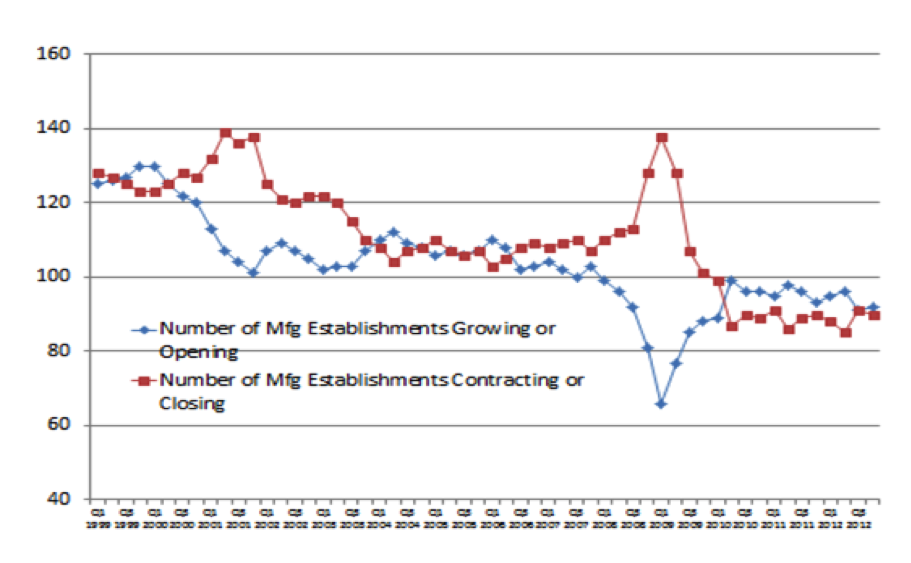Manufacturing Innovation Blog
Powered by the Manufacturing Extension Partnership

15 a day. That is how many manufacturing establishments have closed every day (including weekends and holidays) over the last 13 years. The journey to getting to this factoid is typical of my discursive and pedantic thinking and writing but I think it worth recounting this journey.
It started a few days ago when I was talking to my oldest son about the shopping center near our house that is being torn down and rebuilt after several years sitting idle. We recounted the various stores and eateries that existed in this shopping center in its glory days-- the loss of the local baseball card shop was most significant to me while, of course, for my son it was the loss of one of his favorite eating establishments. All this musing on change and the past got me thinking about the changes that I’ve seen take place in my hometown of Warren, Ohio, and the various manufacturing establishments that were there when I was growing up. Many of them are no longer there at all or are, frankly, simple shells of their former selves. I won’t recount those losses (though they are substantial) but that got me wondering about the bigger picture, about what has happened with manufacturing over the last several years. Being a data person, I decided to check the facts and get some context. I know folks like to cite Joseph Schumpeter and his notion of the gales of creative destruction, but we also know that job displacement has long-term and significant costs. It works out that the U.S. has lost about 15 manufacturing establishments every day (including weekends and holidays).
To discover this, I did some research using County Business Patterns for data from 1998 to 2011. I used 1998 as the starting point (2011 is the most current data available, and 1998 is the earliest year for use of the current methodology in “counting” manufacturing). Between 1998 and 2011, the U.S lost about 71,000 manufacturing establishments, roughly 19%. I don’t know if I was surprised by this number, truthfully, but like lots of things, I needed to work the data into something meaningful, something impactful. So, I decided to calculate how many manufacturing establishments that means the U.S. has lost on a daily basis. At that point, I was both shocked and surprised. It was 15 a day.
Then, because I am apparently a glutton for punishment, I decided to look at some data assembled by the Bureau of Labor Statistics on business dynamics. BLS provides data on the number of manufacturing establishments that having opened, closed, grown (added employment), or contracted (lost employment). I went back to Q1 1999 and tracked the numbers quarterly up through Q4 2012. What shocked me about this chart was the significant jump in the number of manufacturing establishments that closed or contracted over the recessions in 2001 and 2008 but also the significant secular drop in the number of firms opening or expanding. While more recent data points to the number of establishments opening or expanding exceeding that of the number closing or contracting, the gap is small. Most importantly, I believe we see a significant drop in the underlying dynamism in manufacturing: although we simultaneously have establishments growing and opening alongside establishments contracting and closing, the rates for each appear to be slowing.
Establishment Churn in Manufacturing, 1999-2012

Source: U.S. Bureau of Labor Statistics, Business Employment Dynamics
I don’t know what you think, but this suggests to me an important set of issues as we think about manufacturing that we seldom talk about. As pointed out by Ryan Decker and his colleagues, the decline in economic dynamism is a significant problem and one that has important implications for job and productivity growth. Unfortunately, we don’t know or understand the reasons for the decline, but I think they likely represent a number of factors. That also means that we cannot point to a single solution either.
About the author
Related Posts
Comments
- Reply


